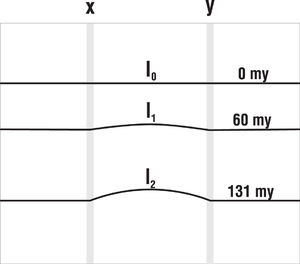Difference between revisions of "Top seal strain estimation"
FWhitehurst (talk | contribs) |
m (Molyneux moved page Estimating strain in top seals to Top seal strain estimation) |
(No difference)
| |
Revision as of 20:29, 19 December 2014
| Exploring for Oil and Gas Traps | |

| |
| Series | Treatise in Petroleum Geology |
|---|---|
| Part | Predicting the occurrence of oil and gas traps |
| Chapter | Evaluating top and fault seal |
| Author | Grant M. Skerlec |
| Link | Web page |
| Store | AAPG Store |
Once the ductility or paleoductility of a seal is known, the amount of strain that has affected the seal must be determined. One of the most useful techniques is incremental strain analysis. Originally applied to fractured reservoirs[1] the technique is equally applicable to top seal analysis ([2][3] Koch et al., 1992).
Incremental strain analysis
Incremental strain analysis measures the change in line length of sequence boundaries on depth-converted seismic lines to calculate strain magnitude as well as the strain occurring at different time intervals. The advantages of this technique are that it can be applied to prospects before drilling and it yields a quantitative estimate of strain that can be compared directly with strain measurements of top seals in the laboratory. Incremental strain analysis yields not only a quantitative strain value but also shows how strain has varied with time.
Calculating incremental strain
Figure 1 is a simple cross section of a low-relief salt structure showing three seismic sequences. The figure shows how strain is calculated: by comparing the original undeformed line length with the deformed line length between two arbitrary points, A and B. In this figure, 10 is the initial, undeformed line length; 11 is the deformed line length of the 60-m.y sequence boundary; and 12 is the deformed line length of the 131-m.y. sequence boundary. The strain (ε) on the 131-m.y sequence boundary is ε = (12 – 10)/10 = 2.5%. The strain on the 60-m.y. sequence boundary is ε = (l1 – 10)/10 = 0.5%. All strains are extensional.
This method provides both an estimate of quantitative strain and the timing of strain. The incremental strain is the strain occurring during the time interval between two sequence boundaries. In the preceding figure, 0.5% strain occurred between 60 Ma and the present, while 2.5% strain occurred between 131 Ma and the present. Consequently, 2.0% strain occurred between 60 and 131 Ma. Strain–time plots display the strain affecting the top seal from the onset of deformation to the present.
Correction for compaction
Analysis requires decompaction of the sediments to correct for the apparent strain caused by compaction. In the Central Graben, the effect is generally minimal.
Empirical threshold for top seal failure
How much strain can a top seal withstand? In a mature basin, risk assessment of the strain threshold at which failure occurs is determined empirically by analyzing successes and failures. The empirical threshold varies from basin to basin. In a frontier setting, estimates of the strain required for failure must be based on (1) laboratory data on seal properties and (2) estimates of the confining pressure and seal ductility at the time of trap formation.
Limitations of incremental strain analysis
Incremental strain analysis provides only an estimate of strain. More detailed calculations of stain may be warranted. Incremental strain analysis is an average of strain over the entire structure. Local areas of high strain can have important control on spill points. Recent analyses have taken shorter line-length increments over the structure to calculate small-scale variations in strain (Koch et al., 1992). In addition, the method assumes fixed end points, whereas a limited amount of flexural slip occurs.
See also
- Strain analysis of top seals
- Seal ductility
- Estimating ductility of top seals
- Example: evaluating top seal integrity
References
- ↑ Watts, N., L., 1983, Microfractures in chalks of the Albuskjell field, Norwegian sector, North Sea: possible origin and distribution: AAPG Bulletin, vol. 67, no. 2, p. 201–234.
- ↑ Skerlec, G., M., 1982, Risking top seals in the Central Graben: Exxon Production Research Company internal report.
- ↑ Skerlec, G., M., 1990, SEALS: A short course for risking top seal and fault seal: Franklin, Pennsylvania, SEALS International, 600 p.
